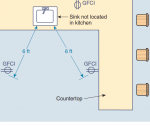John Rutherford
New User
- Location
- Ohio
- Occupation
- Inspector
GFCI Receptacles in 210.8 in the 2017 NEC states they must be readily accessible. I say they are not readily accessible in either location. Behind refrigerator you would have to move the refrigerator, under sink you would have to open cabinet doors and move stuff around to get to the GFCI receptacle. What is the answer?


